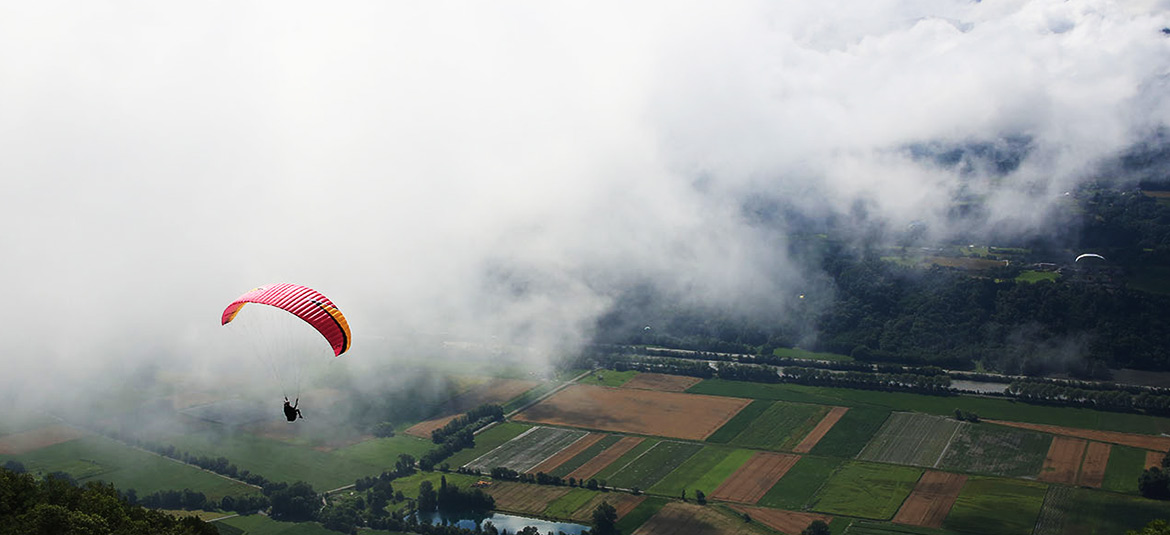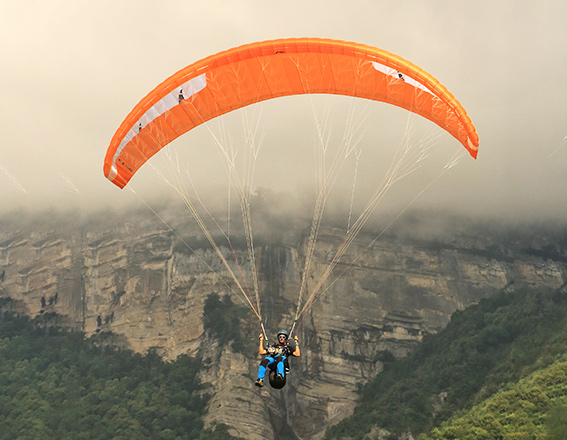Paragliding weather : what are the best conditions for paragliding ?


Paragliding is an aerial sport highly dependent on weather conditions. To ensure a safe and rewarding experience, it's crucial to understand and anticipate climatic variations. From wind speed to atmospheric stability, let's discover the ideal conditions for paragliding.
WEATHER CONDITIONS FOR PARAGLIDING
Calm, gentle, well-directed winds
One of the first things to check before taking off is the direction and speed of the wind or breeze. A stable wind, blowing steadily and not gusty, is ideal for take-off and stable flying. In paragliding, a wind speed of between 5 and 15 km/h is generally considered favorable. Too light a wind will make take-off slightly more difficult, while too strong a wind can be dangerous.
No precipitation
Although paragliding is technically possible in the rain, we strongly advise against it. Precipitation can make the glider heavier, reduce visibility and make control more difficult or impossible. In addition, wet ground makes take-off and landing slippery and potentially dangerous. All of these factors can put a pilot's life in great danger.
No thunderstorms
Thunderstorms pose a serious threat to paragliders. Lightning, heavy precipitation and sudden gusts can make flying unpredictable. What's more, thunderstorms are often associated with phenomena such as thermal lift, which can suck a paraglider up to dangerous altitudes.
Atmospheric stability
A stable atmosphere offers smooth, quality flight, while an unstable atmosphere can generate turbulence. Thermal updrafts, typical of an unstable atmosphere, can be both an asset for gaining altitude, and a danger if too powerful or unpredictable.
WHAT'S THE BEST WEATHER FOR PARAGLIDING IN WINTER ?
Paragliding in winter presents unique challenges. Winter conditions often involve low temperatures, which can affect piloting and comfort. It is essential to wear suitable equipment to avoid suffering from the cold. What's more, snow on the ground can make take-offs difficult. Winter days often offer a more stable atmosphere, with fewer thermals, but the daylight hours are reduced, which limits flying time. These are often ideal conditions for beginners !
WHERE TO CHECK THE WEATHER FOR A PARAGLIDING FLIGHT ?
The weather plays a crucial role in paragliding. It's imperative to consult reliable sources for precise information on aerological conditions.
-
Paragliding weather : This is surely the site most consulted by paragliding enthusiasts. It brings together all the information you need to plan your flights, and is exceptionally easy to read! With photos, webcams, forecasts and beacons on a world map, the site is practical and indispensable for paragliders !
-
Météo France : This national website offers detailed forecasts and specific bulletins for mountain and air activities.
-
XC Skies : Specialized in air sports weather, it offers accurate maps and forecasts of winds, thermals and other essential parameters.
-
Paragliding Map : In addition to information on take-off and landing sites, this site provides meteorological data for paragliding.
-
For further information: For more experienced pilots requiring more detailed data, you can find a plethora of information on sites such as Metoffice, Meteoblue, Meteociel, Meteo parapente etc...

HOW TO READ AN EMAGRAM ?
The emagram is a graph showing temperature and humidity variations with altitude. It is essential for anticipating thermal conditions and atmospheric stability.
-
The vertical axis : This represents altitude, often in atmospheric pressure (hPa).
-
Horizontal axis : Shows temperature. Two main curves are plotted: ambient temperature and dew point.
The difference between these two curves gives an idea of the humidity of the air. The further apart they are, the drier the air. If they are closer together, this indicates an area where condensation is likely, signalling the presence of clouds or fog.
The direction and shape of the ambient temperature curve give an indication of atmospheric stability. If this curve deviates from the vertical with altitude, this indicates an unstable atmosphere, conducive to the formation of thermals.
Learning to read an emagram takes time and practice, but it's an invaluable tool for any paraglider wishing to maximize their flying experience.
In conclusion, meteorology and paragliding are intimately linked. Every flight must be preceded by a careful analysis of the weather conditions to ensure a safe and enjoyable experience.
DISCOVER ALL THE PARAGLIDING FAQ :
Paragliding FAQ: Frequently Asked Questions about Paragliding
Paraglider wing folding step by step
Storage of paragliding equipment: how to maintain your equipment ?
Paraglider revision : when and how to have your equipment checked ?
How to choose a paragliding school ?
Paragliding airspace: how does it work ?
Where to buy paragliding equipment ?
What are the requirements for registering a paramotor wing in France ?








